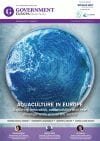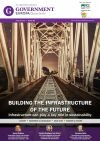
Government Europa speaks to Dr. Vassilis Agouridas of Airbus and EIP-SCC Urban Air Mobility initiative leader, on the topic of flying cars, drones and utilising the third dimension
European cities are seeing ever more challenges to mobility in urban areas and therefore enabling efficient and effective mobility is at the top of the European transport agenda. Throughout Europe, cities and regions are preparing to welcome the take-off of flying vehicles and drones in their pursuit to become smarter and more sustainable. The European Commission is supporting the development of urban air mobility demonstrators through the Urban Air Mobility (UAM) Initiative of the European Innovation Partnership in Smart Cities and Communities (EIP-SCC). These mobility demonstrators, which are shaped and led around city-led consortia, aim to ultimately deliver scalable and replicable civic services by capitalising on the benefits from adding the third dimension to urban mobility.
The European Parliament also recently backed legislation on ensuring the safe use of drones in the European Union. The space above our heads is the only uncongested area of our cities and this is one of the driving factors for which drones are being considered to transport goods and even provide a means of travel. Many cities and regions have now started innovating with urban air mobility to increase, for example, citizen safety through emergency response, while putting in place the fundamental pillars to improve, in the near future, their intermodal transport ecosystem.
The UAM Initiative is hosted under the EIP-SCC’s sustainable urban mobility action cluster and is essentially a marketplace platform for urban air mobility that brings together cities and regions together with a diverse set of stakeholders (e.g. regulators, institutions, start-up and established companies), thus allowing urban air mobility solutions to be innovated and showcased. Government Europa Quarterly speaks to Dr. Vassilis Agouridas, the leader of the UAM Initiative of the EIP-SCC, to illuminate how the initiative works and to explain how advances in urban mobility, particularly urban air mobility, can make our transport systems more sustainable.
How does the Urban Air Mobility Initiative of the EIP-SCC encourage market interaction between cities and various stakeholders and how is the partnership helping to bring innovation and development into European urban mobility systems?
From the very beginning, the UAM Initiative has always been city-centric and citizen needs-driven. We are not here to go to test-bed technological advancements and we are not here for pilot projects of technology, we are here for the cities and their citizens. We start from the cities and work with them to see, if, and how the upcoming capabilities (technology and business) as well as newly emerging regulatory and operational frameworks for urban air mobility could be implemented and eventually integrated into their modal system – to improve their mobility services for their citizens.
Cities and regions that wish to engage in the UAM Initiative need to first evaluate whether they have a clear mobility need that could be potentially and sustainably addressed through urban air mobility. The way in which we help to transform the urban mobility ecosystem is by fostering the voice of the cities at the front of the innovation and by actively involving citizens as co-creators. The aim is to have a more active participation of the citizens and the cities in the emerging public dialogue and debate on developing drone services in the cities.
Different cities have put forward different mobility needs they wish to deal with and the way in which the initiative has been structured is to identify the cities and regions that are willing to be engaged to lead the definition and execution of urban air mobility demonstrators featuring the third dimension to address these needs. The initiative has no funding, it is a marketplace by definition.
Up to end of mid-December, the Urban Air Mobility Initiative is consisting of 17 FrontRunner Cities/Regions (forming 12 demonstrators, including two cross-border involving many cities) and 5 Fellow Cities/Regions. FrontRunners have signed a Manifesto of Intent involving significant preparation in mobilising a wide ecosystem and ensuring the necessary political, institutional (incl. regulatory) endorsement support are in place at front (deadline for FrontRunners was end of September 2018). Fellow Cities/Regions are joining through a ‘swifter’ path by signing a Statement of Intent (deadline 28th February 2019); on the other hand, they have to make the extra effort to put in place by themselves the necessary political and institutional support.
How can smart mobility innovations and solutions help to make mobility and transport more sustainable?
The premise of smart mobility is to capitalise on native digital applications and real-time data and information to optimise the intermodal interfaces and eventually the effectiveness and efficiency of travel, thus consequently reducing traffic congestion and the amount of CO2 being emitted into the atmosphere. To this end, the concept of Mobility as a Service (MaaS) is one of the pillars upon which the UAM Initiative demonstrators are building on, in view of combining the different modes and improving the intermodality of transport systems, in order to minimise the mobility footprint per person. For example, in a similar way that instead of using four vehicles for moving four people, we can combine their trips and use one vehicle for four people, the same applies to future and sustainable urban air mobility.
This modal shift will further boost the emergence of mobility systems which are a mix between public and private transport, for example, using trams, metros, taxis and ride-sharing digital platforms. To this end, as part of MaaS, and of wider Intelligent Transport System (ITS) landscape, we have to bring all of this together to existing urban planning, hence the need to involve all transport actors. We have to reconsider the boundaries of urban space that is not only on the ground, but also in the third dimension. Being innovative in how we travel, not only in terms of what the technology can do, but primarily on what we, as citizens, want the technology to do for us, is the most important factor for sustainable and publicly favourable transport.
How do cities with a need for urban air mobility solutions benefit from the implementation of flying vehicles and drones?
There are a range of benefits related to the scaling up and implementation of urban air mobility. These include medical deliveries or drones for emergency services (including drone ambulances), surveillance security, and autonomous air vehicles for passengers. The underlying principle is that urban air mobility should be an efficient, effective and sustainable complement to conventional transport systems.
Many cities are looking to manage traffic congestion and utilising the third dimension is one way of achieving this. However, cities and citizens also want to ensure the sky doesn’t become overly congested; this is something that our cities and regions are seriously taking into consideration and this is where public involvement early and co-creation with citizens becomes crucial. The conventional cars which we are using today are not widely welcome in city centres any more, as they contribute to air and noise pollution with consequences to health and urban life norms. However, we have accepted them due to the benefits they provide in terms of convenience and freedom of movement. This could be the case with drones, whether it is a passenger drone, or a drone being used for emergencies or deliveries. With the current technologies available, they still make noise and they still pose the potential issue of visual pollution. Although technologies evolve, urban air mobility safety regulations are still very strict. Even if everything is safe and there are no accidents, we will most certainly witness public debates on the trade-offs we will need to make as a society for the benefits we’ll receive. We have to contemplate these things in advance in order to shape our desired collective vision for future mobility.
What challenges do we need to consider in the development of regulatory frameworks for urban air mobility?
One of the questions that surrounds urban air mobility is how we will manage and regulate the use of airspace. For example, aeroplanes are restricted to certain flight slots and certain flight paths; in the same lines, ongoing projects and initiatives from the related institutional organisations and regulatory agencies, at European and national levels, focus on these air traffic and air safety fronts from the technological and operational perspectives in the context of urban air mobility.
The role of cities and consequently of their citizens becomes ever important in the shaping of the relevant regulatory frameworks. For example, we all want flying vehicles to be safe and to meet the requirements of low or zero emissions (CO2 or noise) and minimal visual pollution. However, if we as citizens want a hop-on hop-off system of travel in the sky, then we have to accept that the skies will be inevitably busy and we have to agree that we are happy with that. It has become clear during our early work with cities and regions that the general consensus amongst city dwellers is that the sky should give priority to the medical emergencies and inclusive transport (e.g. elderly people), not just ‘VIP’ citizens who can afford it. This is part of the public debate on how we, as society, want to shape the future of urban air mobility. If we as citizens believe the benefits outweigh the costs, in a sustainable manner, then this could be our acceptable and favourable state-of-affairs and would be reflected accordingly to the regulatory frameworks.
How can we encourage confidence amongst citizens that self-piloted flying vehicles and drones will be more beneficial and safer than other conventional modes of transport?
Looking at the safety statistics in transport, the highest percentage of accidents are due to human error. Therefore, generally in all modes of transport, including aviation which is the safest mode of transport, there is advanced work on further boosting safety levels by removing the human factor errors by leveraging new technologies, such as artificial intelligence, machine learning and advanced sensors. By further automating systems, and eventually making them autonomous, we can repeatedly do things correctly, thus eliminating the human factor error.
What does the future hold for sustainable transport and urban air mobility as cities become smarter?
We should expect to see more integrated solutions where one mode of transport will act synergistically with one of more other modes. It is vital that we take a system-of-systems approach to urban air mobility to ensure that we truly benefit from more efficient transport modes and systems, capitalising on available technologies, reducing operating costs, making mobility more affordable, and ultimately reducing our collective energy and carbon footprint. In the end, cities and their citizens should be in the driver’s seat of this progress.
Dr Vassilis AGOURIDAS
Senior Manager, Strategic Innovation at AIRBUS
UAM Initiative Leader, EIP-SCC



















Nothing smart about urban air mobility.
Airtaxis and flying cars as an urban mobility option will never be as efficient per passenger and UAM can’t move even a small percentage of the people rapid bus transport, trains, hyperloop and futran systems can. If we are going to solve the urban mobility problem and tackle traffic congestion, fight climate change and make our cities liveable again, money should rather be spent on mass transit systems like Elon’s hyperloop not Dara’s Jetson fantasy.
My take: https://www.linkedin.com/feed/update/urn:li:activity:6493726144708247552